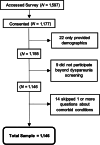High rate of dyspareunia and probable vulvodynia in Ehlers-Danlos syndromes and hypermobility spectrum disorders: An online survey
- PMID: 34747110
- PMCID: PMC8665058
- DOI: 10.1002/ajmg.c.31939
High rate of dyspareunia and probable vulvodynia in Ehlers-Danlos syndromes and hypermobility spectrum disorders: An online survey
Abstract
Vulvodynia is debilitating vulvar pain accompanied by dyspareunia (pain with sexual intercourse). Ehlers-Danlos syndromes (EDS) and hypermobility spectrum disorders (HSD) may represent a predisposing factor for vulvodynia given a high rate of dyspareunia in these conditions. We conducted an online survey of women with EDS or HSD to assess rates of dyspareunia and estimate rates of vulvodynia, report rates of comorbid conditions common to EDS or HSD and vulvodynia, and examine rates of conditions contributing to dyspareunia in women with EDS or HSD. Women with EDS or HSD (N = 1,146) recruited via social media were 38.2 ± 11.5 years old, primarily White (94.4%), and resided in the United States (78.5%). 63.7% of participants reported dyspareunia and 50% screened positive for vulvodynia. The rate of comorbid conditions common to EDS or HSD and vulvodynia were: irritable bowel syndrome, 6.5%; fibromyalgia, 40.0%; temporomandibular joint dysfunction, 56.4%; migraine, 6.7%; interstitial cystitis, 1.7%; and mast cell activation syndrome, 10.2%. Participants reporting dyspareunia also reported ovarian cysts, fibroids, or abdominal or pelvic scars, 47.5%; endometriosis, 26.5%; and genital lacerations, 19.3%. Women with EDS or HSD may have a higher rate of vulvodynia (50.0%) than women in the U.S. population at large (8%) and should be assessed for dyspareunia and vulvodynia.
Keywords: Ehlers-Danlos syndromes; dyspareunia; pelvic pain; social media; vulvodynia.
© 2021 The Authors. American Journal of Medical Genetics Part C: Seminars in Medical Genetics published by Wiley Periodicals LLC.
Conflict of interest statement
The authors have no conflicts of interest to disclose.
Figures






Similar articles
-
Patient experience of chronic illness care and complementary integrative health use: a cross-sectional study of patients with hypermobility spectrum disorders (HSD) and Ehlers-Danlos syndromes (EDS).Disabil Rehabil. 2023 Oct;45(21):3549-3559. doi: 10.1080/09638288.2022.2131003. Epub 2022 Oct 12. Disabil Rehabil. 2023. PMID: 36222285
-
Urogenital and pelvic complications in the Ehlers-Danlos syndromes and associated hypermobility spectrum disorders: A scoping review.Clin Genet. 2020 Jan;97(1):168-178. doi: 10.1111/cge.13624. Epub 2019 Sep 1. Clin Genet. 2020. PMID: 31420870 Free PMC article.
-
Pain and gastrointestinal dysfunction are significant associations with psychiatric disorders in patients with Ehlers-Danlos syndrome and hypermobility spectrum disorders: a retrospective study.Rheumatol Int. 2019 Jul;39(7):1241-1248. doi: 10.1007/s00296-019-04293-w. Epub 2019 Mar 28. Rheumatol Int. 2019. PMID: 30923956
-
Clinical characteristics of patients with hypermobile type Ehlers-Danlos syndrome (hEDS) and generalized hypermobility spectrum disorders (G-HSD): an online survey.Rheumatol Int. 2023 Oct;43(10):1935-1945. doi: 10.1007/s00296-023-05378-3. Epub 2023 Jun 28. Rheumatol Int. 2023. PMID: 37378685
-
A review of respiratory manifestations and their management in Ehlers-Danlos syndromes and hypermobility spectrum disorders.Chron Respir Dis. 2021 Jan-Dec;18:14799731211025313. doi: 10.1177/14799731211025313. Chron Respir Dis. 2021. PMID: 34291699 Free PMC article. Review.
Cited by
-
Treating pain in patients with Ehlers-Danlos syndrome : Multidisciplinary management of a multisystemic disease.Schmerz. 2024 Feb;38(1):12-18. doi: 10.1007/s00482-023-00778-7. Epub 2024 Jan 8. Schmerz. 2024. PMID: 38189943 Review. English.
-
Female reproductive health impacts of Long COVID and associated illnesses including ME/CFS, POTS, and connective tissue disorders: a literature review.Front Rehabil Sci. 2023 Apr 28;4:1122673. doi: 10.3389/fresc.2023.1122673. eCollection 2023. Front Rehabil Sci. 2023. PMID: 37234076 Free PMC article. Review.
-
Sexual dysfunction in women with hypermobile Ehlers-Danlos syndrome and hypermobility spectrum disorders: an online community-based study.Rheumatol Adv Pract. 2025 Feb 27;9(2):rkaf023. doi: 10.1093/rap/rkaf023. eCollection 2025. Rheumatol Adv Pract. 2025. PMID: 40177006 Free PMC article.
-
Whither social media and clinical genetics?Am J Med Genet A. 2023 Jun;191(6):1489-1491. doi: 10.1002/ajmg.a.63166. Epub 2023 Mar 2. Am J Med Genet A. 2023. PMID: 36863700 Free PMC article. Review.
-
Sexual Dysfunction in Postural Orthostatic Tachycardia Syndrome (POTS): A Cross-Sectional, Case-Control Study.J Clin Med. 2024 Apr 14;13(8):2274. doi: 10.3390/jcm13082274. J Clin Med. 2024. PMID: 38673548 Free PMC article.
References
-
- Backonja, M. M. , & Argoff, C. E. (2005). Neuropathie pain‐definition and implications for research and therapy. Journal of Neuropathic Pain & Symptom Palliation, 1(2), 11–17. 10.3109/J426v01n02_03 - DOI
Publication types
MeSH terms
Grants and funding
LinkOut - more resources
Full Text Sources
Medical

